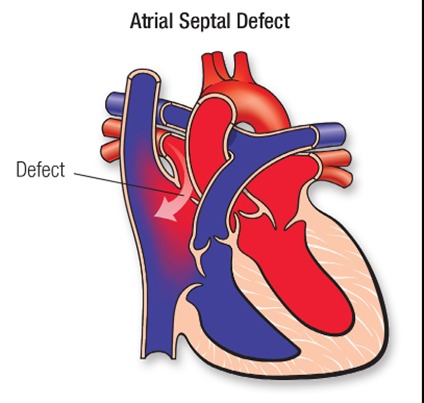ASD
An atrial septal defect (ASD) is a hole in the heart between the pper chambers (atria). The hole increases the amount of blood that flows through the lungs. The condition is present at birth (congenital heart defect).
Small atrial septal defects might be found by chance and never cause a concern. Others close during infancy or early childhood.
A large, long-term atrial septal defect can damage the heart and lungs. Surgery may be needed to repair an atrial septal defect and to prevent complications.
Symptoms
Many babies born with atrial septal defects have no signs or symptoms. Signs or symptoms can begin in adulthood.
Atrial septal defect signs and symptoms can include:
- Shortness of breath, especially when exercising
- Fatigue
- Swelling of legs, feet or belly (abdomen)
- Irregular heartbeats (arrhythmias)
- Sensation of a rapid, pounding heartbeat (palpitations) or skipped beats
- Whooshing sound that can be heard through a stethoscope (heart murmur)
TREATMENT
Many cardiologists recommend surgery to repair a medium to large atrial septal defect that’s diagnosed during childhood or adulthood to prevent future complications.
For adults and children, atrial septal defect repair surgery involves closing the hole in the heart. This can be done two ways:
- Catheter-based repair.A thin, flexible tube (catheter) is inserted into a blood vessel, usually in the groin, and guided to the heart using imaging techniques. A mesh patch or plug is passed through the catheter and used to close the hole. Heart tissue grows around the seal, permanently closing the hole.
- Open-heart surgery.This type of atrial septal defect repair surgery involves an incision through the chest wall to access the heart directly. The surgeons use patches to close the hole. This open-heart repair surgery is the only way to fix primum, sinus venosus and coronary sinus atrial defects.
Sometimes, atrial septal defect repair can be done using small incisions (minimally invasive surgery) and with a robot (robot-assisted heart surgery).
Benefits of Transcatheter ASD Closure
Closing an ASD helps improve your heart function and reduces your risk of complications associated with ASD, which can include heart failure and stroke. Without treatment, an ASD may allow excess blood to leak to the lungs, causing lung damage.
Because catheter-based ASD closure doesn’t require a large incision, the procedure offers significant benefits. Patients typically recover more quickly than from open-heart surgery, spending less time in the hospital and experiencing fewer complications. Our patients also report less pain following catheter-based procedures.
The ASD closure device is designed to flatten against your septum and seal the hole. Immediately after surgery, the device stays in place because of the natural pressure in your heart. Over time, your heart tissue grows around the ASD closure device.
You usually spend one night in the hospital before returning home.
